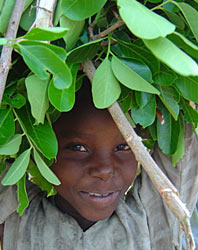TV Program Description
Original PBS Broadcast Date: November 20, 2007
Deep within a termite mound in Africa, soldier termites spring
into action, slicing their smaller opponents in half with a
snap of their powerful jaws. But the attacking driver ants use
strategy to overwhelm the defenders. Little do these
six-legged combatants know that their marching orders come
from a drought-plagued human village that is counting on them
to drive out the termites.
Filmed in High Definition with advanced macro-shooting
techniques, "Master of the Killer Ants" garnered best film
awards at the Shanghai Film Festival and Japan's Wildlife Film
Festival. The stunning footage includes different castes of
termites coursing through their intricate tunnels—and
the monstrously egg-swollen queen herself, rippling with the
contractions that deposit thousands of eggs per day. (For more
on the queen phenomenon, see
Being Queen.) The
climax comes as the invading driver ants close in on the
queen's royal cell.
Although known for their ruthless aggression, driver ants also
have a beneficial side. This is traditionally exploited by the
Mofu people of northern Cameroon, who call the local species
of red driver ants jaglavak. (To hear more of the Mofu
and their traditions, go to
Jaglavak, Prince of Insects).
"Master of the Killer Ants" tells the story of the Mofu's
intimate relationship not only with jaglavak but with other
insects. For instance, the people know that a crablike,
bright-red insect serves as a harbinger of rain and a sign
that it is time to prepare the earth. Winged insects and
grasshoppers make a valuable food supplement and are
especially tasty when grilled. (For more on edible insects,
see Bugs You Can Eat).
But the insects provide a guide to behavior as well as an aid
to survival. The Mofu say that they must work as hard and
selflessly as the ants and termites if they are to survive,
and they attribute drought and misfortune to their moral
shortcomings.
One special quality of jaglavak above all concerns the village
elder Matsgrawaï. When the film opens, he is called to
inspect a neighbor's house. Termites have infested the earthen
floor and are attacking the walls and roof. Worst of all, they
threaten the adjacent granary with its crucial stock of grain
sorghum.
From past experience, Matsgrawaï knows that jaglavak can
drive the termites away, thereby securing the grain sorghum
stores on which the villagers' lives depend. Under special
circumstances, driver ants will attack termite colonies, and
Matsgrawaï begins with prayers and offerings to jaglavak.
When the ants fail to show up, he sends children to seek them
out. (Play our
Amazing Ants Game).
Thus commences a charming, instructive true-life fable on how
to fight fire with fire—termites with ants—and not
get burned, or rather too badly stung, in the process.

Program Transcript
Program Credits

